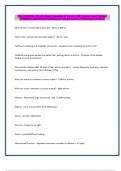NSG 212 FINAL EXAM, Huber | Questions & Answers (100 %Score) Latest Updated
2024/2025 Comprehensive Questions A+ Graded Answers | With Expert Solutions
What should a normal daily output be? - About 2,400 mL
What is the minimal expected adult output? - 30 mL / hour
Inefficient emptying of the bladder can lead to: - Residual urine increasing the risk for UTIs
Childbirth and gravity weaken the pelvic floor, putting clients at risk for: - Prolapse of the bladder,
leading to stress incontinence
The prostate enlarges after 40 years of age, which can lead to: - urinary frequency, hesitancy, retention,
incontinence, and urinary tract infections (UTIs).
What can cause an increase in urinary output? - Caffeine, alcohol
What can cause a decrease in urinary output? - High sodium
Polyuria - Abnormally large amounts of urine. (2,500 mL/day)
Oliguria - scant amounts (less than 500ml/day)
Anuria - less than 100ml/day
Nocturia - frequency at night
Dysuria - painful/difficult voiding
Maturational Enuresis - repeated involuntary urination in children > 4-5 years
,Nocturnal Enuresis - Bed wetting during the night in kids
What factors are associated with urinary retention? - Medications, an enlarged prostate, vaginal
prolapse
Normal BUN levels - 6 - 20mg/dL
What is a normal GFR? - > 60 if Caucasian, > 50 if AA
Stage 1 renal failure - 60 - 45
Stage 2 renal failure - 45 - 30
Stage 3 renal failure - 30 - 15
Stage 4 renal failure - 15 - 0
Normal CR levels - 0.6 - 1.3
If both BUN and CR are elevated, this usually indicates: - True renal dysfunction
What does a UA tell us? - if there is stuff in the urine
What are the normal urine specific gravity values? - 1.015 - 1.025
What does a urine specific gravity of < 1.015 tell us? - It is diluted, so the PT is overhydrated
What does a urine specific gravity of > 1.025 tell us? - It is more concentrated, so the PT is dehydrated
,What type of technique is the clean-catch? - Clean, non-sterile
What type of technique is catheter urine specimen? - Surgical asepsis (sterile)
How do you collect a 24 hour urine? - Discard first sample, save all urine after that, label and keep in
fridge
What is an Intravenous Pyelogram? - Injection of contrast media (iodine) for viewing of ducts, renal
pelvis, ureters, bladder, and urethra! Allergy to shellfish contraindicates the use of this contrast
medium.
What is a Cystoscopy? - Use of a lighted instrument to visualize, treat, and obtain specimens from the
bladder and urethra
What do you need to select on the bladder scan if the female had a hysterectomy? - The male option
What size catheter would you use for children? - 8 - 10 Fr
What size catheter would you use for women? - 14 - 16 Fr
What size catheter would you use for men? - 16 - 18 Fr
What can digital removal of impaction cause? - Injury or vagal response
What can you add to your diet to return regular flora? - Yogurt, buttermilk, banana flakes
What color should a stoma be? - Beefy red
, What type of drainage, content, odor and need to be emptied are associated with an Ileostomy? - Liquid
drainage, enzymes (very acidic), minimal odor,
MUST BE EMPTIED MORE FREQUENTLY
What type of drainage, content, odor and need to be emptied are associated with an Ascending
Colostomy? - liquid, enzymes (acidic), odor, frequent emptying
What type of drainage, content, odor and need to be emptied are associated with a Transverse
Colostomy? - Odorous, mushy drainage without control
What type of drainage, content, odor and need to be emptied are associated with a Descending
Colostomy? - solid, can be regulated, odor, most like "normal" bowel movements, may only need
emptied once a day
What are End Stomas a result of? - Colorectal cancer or some type of bowel disease
What are Loop Colostomies and what are they used for? - help resolve a medical emergency and are
temporary.
In a loop colostomy, a loop of bowel is supported on the abdomen with a proximal stoma draining stool
and a distal stoma draining mucus. It is usually constructed in the transverse colon.
What is a Double-barrel Colostomy and what is it used for? - consist of two abdominal stomas:
one proximal and one distal.
The proximal stoma drains stool
The distal stoma leads to inactive intestine
After the injured area of the intestine heals, the colostomy is often reversed by reattaching the two ends
-- not in emergencies




